
WHAT WE TREAT
Menopause is when a woman or person assigned female at birth stays 12 consecutive months without a menstrual cycle.
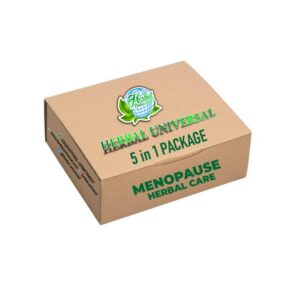
Herbal products are widely used as an alternative to pharmacological therapy in managing menopausal symptoms such as hot flashes, mood changes, insomnia, night sweats, fatigue, vaginal dryness, and sexual dysfunction, etcetera. In addition, gynaecological disorders such as premenstrual syndrome and dysmenorrhoea are equally treated using herbal products due to the fact that pharmacological therapy often has serious side effects (Kenda et al, 2021). The use of herbal products in managing these symptoms is based on long-standing traditional medicine practices. Some are supported by scientific proof ,while others are not. Indeed, there is a need for more research regarding their efficacy and safety in the management of these symptoms.
The types of herbs used in managing menopausal symptoms vary widely. However, Herbal Universal 5-in-1 Full-Package has been naturally formulated to manage these symptoms perfectly and cleanse the womb for women who want to go for an in vitro fertilization (IVF) in order to present a conducive environment for implantation and development of the foetus.
A low sperm count, known as oligospermia, is diagnosed when a semen analysis test is performed on an individual. Normal sperm densities are in the range of 15 million to greater than 200 million sperm per millimetre of semen. An individual is said to have a low sperm count if he has fewer than 15 million sperm per millimetre or less than 39 million sperm total per ejaculate.

With decreasing sperm counts, the chances of getting your partner pregnant decrease tremendously.
Other factors involved include sperm motility (the ability of sperm to swim efficiently in a woman’s reproductive system to fertilise an egg). Normal sperm mobility is 40% or more, progressive mobility is 32% or more, sperm concentration is 20,000,000 or more/mL, and sperm morphology (% of normal-appearing sperm) is 4% or more normal.
Herbal Universal low sperm count treatment has been formulated with essential natural supplements to improve the sperm quality or count.
An ovarian cyst is a fluid-filled or semi-solid sac that develops in or on an ovary. They are common, and often present no symptoms, and they do go away on their own. However, some may not go on their own and may increase in size, block blood supply to the ovaries, cause bleeding, and begin to cause discomfort. In such a case, you may have difficulty getting pregnant, even though ovarian cysts do not often affect fertility: heavy periods, irregular menstruation, pelvic pain, pain during sex, fullness, heaviness with a bloated and swollen tummy, frequent need for urination, and difficulty emptying your bowels.
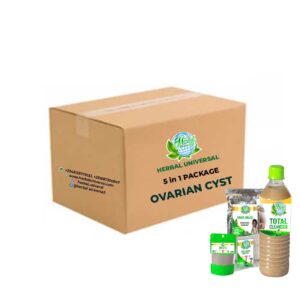 Most ovarian cysts, which are called functional cysts, are formed as a result of the regular menstrual cycle, while others, such as endometrioma, dermoid cyst, and cystadenoma, are not related to menstrual cycles.
Most ovarian cysts, which are called functional cysts, are formed as a result of the regular menstrual cycle, while others, such as endometrioma, dermoid cyst, and cystadenoma, are not related to menstrual cycles.
Therefore, to get rid of these cysts from your body, the Herbal Universal 5-in-1 Full-Package treatment has been naturally formulated to treat these symptoms and get rid of the cysts.
Uterine fibroids, also called leiomyoma, or simply myomas, are non-cancerous growths in the uterus that can develop during a woman’s fertile age until menopause. Uterine fibroids or leiomyoma are capable of causing infertility by blocking the fallopian tubes or preventing fertilized egg from being implanted in the uterus.
 Also, large fibroids may occupy space meant for the development of the fetus in the uterus. They can also cause tubal blockage or damage to the fallopian tubes during surgery. With Herbal Universal fibroids treatment package, the fibroids are pulled out naturally without any human error, which may cause damage to the fallopian tubes during surgery.
Also, large fibroids may occupy space meant for the development of the fetus in the uterus. They can also cause tubal blockage or damage to the fallopian tubes during surgery. With Herbal Universal fibroids treatment package, the fibroids are pulled out naturally without any human error, which may cause damage to the fallopian tubes during surgery.
Pelvic inflammatory disease (PID)/Chronic Infection: Tis occurs when sexually transmitted diseases (STDs) such as gonorrhea, chlamydia, or other infections are left untreated. This may cause long-term scaring and blockages of the fallopian tubes by forming hydrosalpinx, etc.
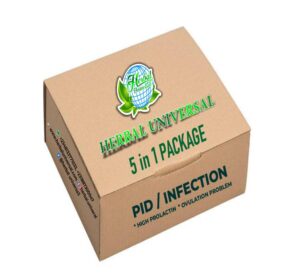 However, with Herbal Universal 5-in-1 Full-Package treatment, the PID/Chronic Infection is flushed out naturally.
However, with Herbal Universal 5-in-1 Full-Package treatment, the PID/Chronic Infection is flushed out naturally.
 is a fluid blockage in the fallopian tubes that may make it difficult for pregnancy to occur. It is caused majorly by untreated infection. At times, pregnancy can
is a fluid blockage in the fallopian tubes that may make it difficult for pregnancy to occur. It is caused majorly by untreated infection. At times, pregnancy can
occur if one of the tubes is healthy, but with a hydrosalpinx in the other tube, the delicate setting of the uterus is likely affected, and this reduces the likelihood of the occurrence of a pregnancy. To overcome this, Herbal Universal 5-in-1 Full-Package treatment has been specially formulated to drain out the fluids naturally.
An irregular menstrual cycle refers to a condition in which a menstrual cycle continually falls outside of established clinical ranges in respect to the time duration and the time it is expected to occur. Most women who menstruate have their menstrual cycle around every 28 days, while others range from day 24 to day 38. The menstrual cycle is regulated by estrogen and progesterone. The two can be affected by natural body changes such as puberty, pregnancy, childbirth, lactation, and menopause.
Irregular periods happen due to many causes, such as hormonal changes, taking hormonal contraception, pelvic inflammatory disease (PID), and other infections; stress; eating disorders; weight gain; endometriosis; fibroids; adenomyosis; Polycystic ovary syndrome (PCOS); etc.
Herbal Universal 5-in-1 Full-Package treatment for irregular or stopped menstruation is naturally formulated to handle the root causes of these menstrual problems and restore the normal flow of menstruation except for cases of menopause.
Hormones are chemical messengers produced by glands in the endocrine system and transported by the bloodstream to the target cells and organs of the body.

Hormonal imbalance occurs when there exists an excess or a limited amount of one or more hormones. Many of these imbalances need treatment, while some may be temporary and vanish away on their own.
Some common hormone-related conditions are irregular menstruation and infertility, which results from Polycystic Ovary Syndrome (PCOS) , amenorrhoea, and a
novulation.
In males, low testosterone levels (hypogonadism).
Herbal Universal 5-in-1 Full-Package for Hormonal imbalance is naturally formulated to take care of these conditions.
The uterine tubes, or fallopian tubes, are bilateral, long, slimline tubes that connect the ovaries to the uterus. It plays an important part in conception and transporting the fertilised egg to the uterus for implantation. Blocked fallopian tubes, or tubal occlusion, are a common cause of infertility.
The most common causes of blocked fallopian tubes are pelvic inflammatory disease (PID), a history of STD infection such as Chlamydia or gonorrhea, a history of uterine infections arising from miscarriage or abortion, myomas (fibroids), surgery, and endometriosis, which may form scar tissue that blocks the fallopian tube.
Apart from difficulty conceiving, blocked fallopian tubes do not present symptoms except in some women. It may cause them to feel pain in their womb,especially during their periods or at times daily.
In some cases, the fertilised egg will get stuck in the fallopian tube, resulting in an ectopic pregnancy. In such a case, immediate medical attention is required from a qualified medical practitioner.When a case of fallopian tube blockage is established medically, with Herbal Universal 5-in-1 Full-Package treatment, the fallopian tubes can be unblocked naturally.
Polycystic ovary syndrome (PCOS) is a common hormonal problem in women of childbearing age. For symptoms:
Irregular or missed menstruation,
Lack of ovulation in some women,
The presence of many small cysts on the ovaries.

Excess hair growth due to overproduction of androgens, which leads to the development of male characteristics, acne, infertility, and weight gain.
PCOS can’t be cured, but the above symptoms could be managed medically.
Like weight gain, regular exercise, changes in lifestyle, eating a balanced diet, etc. can reduce weight gain and take care of those symptoms.
According to the NHS, daily diet should include much of fruits and vegetables (at least 5 portions a day), whole foods (such as wholemeal bread, wholegrain cereals, and brown rice), lean meats, fish, chicken, etc.
The aforementioned symptoms could also be treated medically. So, in our own case, Herbal Universal 5-in-1 Full-Package treatment for PCOS has been naturally formulated to help manage those symptoms.
We have herbal remedies for infertility and infections of different kinds, such as:
⦁ Hormonal imbalance
⦁ The hotness of the womb
⦁ Abnormal menstruation
⦁ Blocked fallopian tubes
⦁ Uterine problems such as uterine fibroids or myomas
⦁ Ovarian Cysts
⦁ Chronic infection
⦁ Low Sperm Production
⦁ Abnormal sperm production
⦁ Pelvic Inflammatory Disease (PID)
⦁ Vaginal infections, etc.
Definition of Some Important Terminologies.
Traditional medicine: The total combination of knowledge, skills and practices, which may be explainable or not and are based on the theories, beliefs and experiences native to different cultures, used in the maintenance of health and in the prevention, diagnosis, improvement or treatment of physical, social and mental illness. It is usually handed down from generation to generation, verbally or in a written form.
Complementary/Alternative Medicine:
This is any practice that aims to achieve the healing effects of medicine even though there exist no established scientific evidence of its effectiveness. According to the World Health Organization (WHO), it is an expansive set of healthcare practices which are neither part of a country’s own tradition nor are fully integrated into the dominant health care system.
Integrated Medicine:
According to the National Center for Biotechnology Information (NCBI), integrated medicine (or interactive medicine as it is called in the United States) is practicing medicine in a way that selectively incorporates elements of complementary and alternative medicine into comprehensive treatment plans alongside solidly orthodox methods of diagnosis and treatment.
Herbal Medicine (also called herbalism, botanical medicine, phytomedicine or phytotherapy:
This is the study of pharmacognosy, which uses medicinal plants as the foundation of traditional medicine. According to WHO, these include herbs, herbal materials, herbal preparations and finished herbal products that contain parts of plants as active ingredients, or other plant materials, or a combination.
Medicinal Plants:
These are also called medicinal herbs. These are any plant which, in one or more of its organs, contains substances that can be used for therapeutic purposes or which are precursors for the synthesis of useful drugs (NCBI). According to WHO, a variety of drugs are obtained from different medicinal plants and a greater percentage (80%) of the world’s developing population are dependent on traditional medicine for their primary health care needs. Medicinal herbs have long been discovered and used in traditional medicine practice s since prehistoric times. Many chemical compounds are synthesized by plants for various functions, which include defense and protection against predators, fungi, diseases, and herbivorous mammals.
Infertility Caused by Damaged or Blocked Fallopian Tubes
The fallopian tubes are two thin tubes which are situated on either side of the uterus and help in conveying mature egg from the ovaries to the uterus. When there is an obstruction in the fallopian tube that prevents the mature egg and the sperm to meet, it is called tubal factor infertility. It is estimated to account for about 25-30% of infertility cases.
When the fallopian tubes are blocked or damaged, the resultant effect typically result to female infertility. This is due to the fact that fertilization of the woman’s egg by the sperm usually takes place in the fallopian tube, and the blockage makes it impossible for the fertilization to take place.
Causes of Tubal Blockage or Damage (Tubal Occlusion
⦁ Pelvic inflammatory disease (PID) is an infection that occurs when sexually transmitted diseases (STDs) such as gonorrhea, chlamydia, or other infections are left untreated. This may cause long-term scaring and blockages of the fallopian tubes.
⦁ Hydrosalpinx is a fluid blockage in the fallopian tubes that may make it difficult for pregnancy to occur. It is caused majorly by untreated infection. At times, pregnancy can
occur if one of the tubes is healthy, but with a hydrosalpinx in the other tube, the delicate setting of the uterus is likely affected and this reduces the likelihood of the occurrence of a pregnancy.
Uterine fibroids also called leiomyoma, or simply myomas are non-cancerous growths in the uterus that can develop during a woman’s fertile age until menopause.
⦁ Ectopic pregnancy: When a fallopian tube is partially blocked, a mature woman’s egg may be fertilized by the sperm along the tube outside the uterus and in the process gets stuck in the tube. This results in an ectopic pregnancy, which requires a medical
emergency because it can lead to the rupturing of the fallopian tubes, which is life threatening and can also render the woman infertile. It is the most common complication of a blocked fallopian tube, which results in the removal of one or both of the fallopian tubes by salpingectomy.
⦁ Endometriosis causes scarring between the end of the fallopian tube and the ovary. It is a condition when the tissue from a woman’s endometrium, or the lining of the womb grows outside of the uterus on other pelvic organs. During menstruation, the endometrium is naturally shed and released as part of the flow from a woman’s body. But, in the case of endometriosis the tissue that grows outside of the uterus does not shed typically as usual. This causes inflammation with a possible formation of a scar tissue. If this happens near the fallopian tubes, it may scar or block the tubes, which results in tubal infertility.
⦁ An earlier Burst Appendix
⦁ Past surgeries involving fallopian tubes, abdominal region, tubal ligation etc. can cause damage to the fallopian tubes.
Symptoms of Blocked Fallopian Tube
⦁ Inability to conceive is one of the major symptoms of a blocked or damaged fallopian tube
⦁ Feeling of pelvic pain, especially around the time of menstruation.
Diagnosis of Tubal Occlusion.
It is sometimes difficult to identify a blocked fallopian because some blocked tubes can be opened and closed at times. Indeed, to ease this difficulty, the following three main tests are usually applicable.
⦁ Hysterosalpingogram (HSG), which is an X-ray test. Here, a harmless dye is injected by a doctor into the womb in order for it to flow into the fallopian tubes. The dye stains in the fallopian tubes are visible on an X-ray. However, if the fluid is unable to flow into the fallopian tubes, a possible case of tubal blockage may be established.
⦁ Sonohysterogram is an ultrasound test, which is similar to the HSG test but builds up a picture of the fallopian tubes using sound waves.
⦁ Laparoscopy also called keyhole surgery, or minimally invasive surgery is a type of surgical procedure where a surgeon makes a small cut in the body and inserts a small tube that has a light source and camera, which transmits images of the inside of the fallopian tubes to a television monitor. Though the procedure is invasive and cannot treat the blockage, doctors hardly recommend it as an early diagnosis. However, it is the most accurate test for blocked fallopian tubes.
Natural Treatment with Herbal Universal 5-in-1 Full-Package without Surgery.
Though other medical treatment solutions for fallopian tube blockage may exist, the safest and the recommended natural treatment for tubal blockage after it is medically diagnosed as explained above, is the use of Herbal Universal 5-in-1 full-package treatment to drain the fluid naturally, or pull out any form of scarring, fibroids, or ovarian cysts from their root blocking the tubes. It is medically safe because it uses the traditional method without any surgical procedure (salpingectomy). The natural method also pulls out fibroids/ myomas, ovarian cysts, and scar tissues formed by endometriosis, etc. naturally using Herbal Universal 5-in-1 full-package. Practical proofs are contained below.

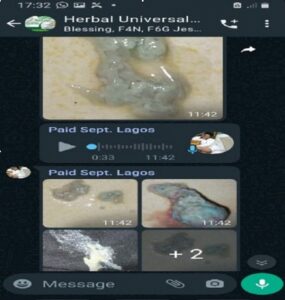

Uterine fibroids also called leiomyoma, or simply myomas are non-cancerous growths in the uterus that can develop during a woman’s fertile age until menopause. Due to the decrease in estrogen and progesterone during menopause, there is less chances of women developing fibroids after menopause. However, women above the age of 50 years can still develop symptomatic fibroids.). According to the Office on Women’s Health, about 20% to 80% of women have fibroids by the age of 50 years old. Similarly, according to “Healthline” by Stacy A. et al, 2022, people are at a greater risk of developing fibroids if they have a family history of fibroids, are 30 years old or above, have a high body weight, and are of African descent, or African American.
They can grow as a single tumor, or there can be many of them in the uterus (multiple fibroids) The symptoms of fibroids may include:
⦁ Severe abdominal or pelvic pain
⦁ Heavy and prolong menstrual flow, which may include clots.
⦁ Pressure or fullness in your lower abdomen
⦁ Increased urination
⦁ Enlargement of the abdomen
⦁ Pain during sexual intercourse
⦁ And, in some cases, there may be no symptoms.
Fibroid Diagnosis
A visit to a standard medical facility is essential for a proper medical examination, which may involve imaging tests such as: ultrasound, CT (Computed Tomography) scan, or pelvic MRI (Magnetic Resonance Imaging). The MRI will help the doctor to understand the number of the fibroids, the location, and the size, and the condition of the uterus.
In figure 3 below, uterine fibroids or leiomyoma are capable of causing infertility by blocking the fallopian tubes or preventing fertilized egg from being implanted in the uterus. Also, large fibroids may occupy space meant for the development of the fetus in the uterus.

Testimonies:


Figure 4. Uterine leiomyoma

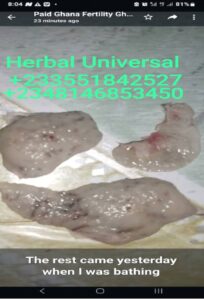

Figure 5: Sample pictures and audio recording from one of our esteemed patients showing uterine myomas or fibroids that blocked the fallopian tubes pulled out naturally by Herbal Universal 5-in-1 full-package treatment.


Figure 6. Fibroids

Figure 7.

Testimonies from Herbal Universal Esteemed Clients who had a chronic infection/pelvic inflammatory disease (PID)
Menopause is when a woman or person assigned female at birth stays 12 consecutive months without a menstrual cycle.

Herbal products are widely used as an alternative to pharmacological therapy in managing menopausal symptoms such as hot flashes, mood changes, insomnia, night sweats, fatigue, vaginal dryness, and sexual dysfunction, etcetera. In addition, gynaecological disorders such as premenstrual syndrome and dysmenorrhoea are equally treated using herbal products due to the fact that pharmacological therapy often has serious side effects (Kenda et al, 2021). The use of herbal products in managing these symptoms is based on long-standing traditional medicine practices. Some are supported by scientific proof ,while others are not. Indeed, there is a need for more research regarding their efficacy and safety in the management of these symptoms.
The types of herbs used in managing menopausal symptoms vary widely. However, Herbal Universal 5-in-1 Full-Package has been naturally formulated to manage these symptoms perfectly and cleanse the womb for women who want to go for an in vitro fertilization (IVF) in order to present a conducive environment for implantation and development of the foetus.
A low sperm count, known as oligospermia, is diagnosed when a semen analysis test is performed on an individual. Normal sperm densities are in the range of 15 million to greater than 200 million sperm per millimetre of semen. An individual is said to have a low sperm count if he has fewer than 15 million sperm per millimetre or less than 39 million sperm total per ejaculate.

With decreasing sperm counts, the chances of getting your partner pregnant decrease tremendously.
Other factors involved include sperm motility (the ability of sperm to swim efficiently in a woman’s reproductive system to fertilise an egg). Normal sperm mobility is 40% or more, progressive mobility is 32% or more, sperm concentration is 20,000,000 or more/mL, and sperm morphology (% of normal-appearing sperm) is 4% or more normal.
Herbal Universal low sperm count treatment has been formulated with essential natural supplements to improve the sperm quality or count.
An ovarian cyst is a fluid-filled or semi-solid sac that develops in or on an ovary. They are common, and often present no symptoms, and they do go away on their own. However, some may not go on their own and may increase in size, block blood supply to the ovaries, cause bleeding, and begin to cause discomfort. In such a case, you may have difficulty getting pregnant, even though ovarian cysts do not often affect fertility: heavy periods, irregular menstruation, pelvic pain, pain during sex, fullness, heaviness with a bloated and swollen tummy, frequent need for urination, and difficulty emptying your bowels.
 Most ovarian cysts, which are called functional cysts, are formed as a result of the regular menstrual cycle, while others, such as endometrioma, dermoid cyst, and cystadenoma, are not related to menstrual cycles.
Most ovarian cysts, which are called functional cysts, are formed as a result of the regular menstrual cycle, while others, such as endometrioma, dermoid cyst, and cystadenoma, are not related to menstrual cycles.
Therefore, to get rid of these cysts from your body, the Herbal Universal 5-in-1 Full-Package treatment has been naturally formulated to treat these symptoms and get rid of the cysts.
Uterine fibroids, also called leiomyoma, or simply myomas, are non-cancerous growths in the uterus that can develop during a woman’s fertile age until menopause. Uterine fibroids or leiomyoma are capable of causing infertility by blocking the fallopian tubes or preventing fertilized egg from being implanted in the uterus.
 Also, large fibroids may occupy space meant for the development of the fetus in the uterus. They can also cause tubal blockage or damage to the fallopian tubes during surgery. With Herbal Universal fibroids treatment package, the fibroids are pulled out naturally without any human error, which may cause damage to the fallopian tubes during surgery.
Also, large fibroids may occupy space meant for the development of the fetus in the uterus. They can also cause tubal blockage or damage to the fallopian tubes during surgery. With Herbal Universal fibroids treatment package, the fibroids are pulled out naturally without any human error, which may cause damage to the fallopian tubes during surgery.
Pelvic inflammatory disease (PID)/Chronic Infection: Tis occurs when sexually transmitted diseases (STDs) such as gonorrhea, chlamydia, or other infections are left untreated. This may cause long-term scaring and blockages of the fallopian tubes by forming hydrosalpinx, etc.
 However, with Herbal Universal 5-in-1 Full-Package treatment, the PID/Chronic Infection is flushed out naturally.
However, with Herbal Universal 5-in-1 Full-Package treatment, the PID/Chronic Infection is flushed out naturally.
 is a fluid blockage in the fallopian tubes that may make it difficult for pregnancy to occur. It is caused majorly by untreated infection. At times, pregnancy can
is a fluid blockage in the fallopian tubes that may make it difficult for pregnancy to occur. It is caused majorly by untreated infection. At times, pregnancy can
occur if one of the tubes is healthy, but with a hydrosalpinx in the other tube, the delicate setting of the uterus is likely affected, and this reduces the likelihood of the occurrence of a pregnancy. To overcome this, Herbal Universal 5-in-1 Full-Package treatment has been specially formulated to drain out the fluids naturally.
An irregular menstrual cycle refers to a condition in which a menstrual cycle continually falls outside of established clinical ranges in respect to the time duration and the time it is expected to occur. Most women who menstruate have their menstrual cycle around every 28 days, while others range from day 24 to day 38. The menstrual cycle is regulated by estrogen and progesterone. The two can be affected by natural body changes such as puberty, pregnancy, childbirth, lactation, and menopause.
Irregular periods happen due to many causes, such as hormonal changes, taking hormonal contraception, pelvic inflammatory disease (PID), and other infections; stress; eating disorders; weight gain; endometriosis; fibroids; adenomyosis; Polycystic ovary syndrome (PCOS); etc.
Herbal Universal 5-in-1 Full-Package treatment for irregular or stopped menstruation is naturally formulated to handle the root causes of these menstrual problems and restore the normal flow of menstruation except for cases of menopause.
Hormones are chemical messengers produced by glands in the endocrine system and transported by the bloodstream to the target cells and organs of the body.

Hormonal imbalance occurs when there exists an excess or a limited amount of one or more hormones. Many of these imbalances need treatment, while some may be temporary and vanish away on their own.
Some common hormone-related conditions are irregular menstruation and infertility, which results from Polycystic Ovary Syndrome (PCOS) , amenorrhoea, and a
novulation.
In males, low testosterone levels (hypogonadism).
Herbal Universal 5-in-1 Full-Package for Hormonal imbalance is naturally formulated to take care of these conditions.
The uterine tubes, or fallopian tubes, are bilateral, long, slimline tubes that connect the ovaries to the uterus. It plays an important part in conception and transporting the fertilised egg to the uterus for implantation. Blocked fallopian tubes, or tubal occlusion, are a common cause of infertility.
The most common causes of blocked fallopian tubes are pelvic inflammatory disease (PID), a history of STD infection such as Chlamydia or gonorrhea, a history of uterine infections arising from miscarriage or abortion, myomas (fibroids), surgery, and endometriosis, which may form scar tissue that blocks the fallopian tube.
Apart from difficulty conceiving, blocked fallopian tubes do not present symptoms except in some women. It may cause them to feel pain in their womb,especially during their periods or at times daily.
In some cases, the fertilised egg will get stuck in the fallopian tube, resulting in an ectopic pregnancy. In such a case, immediate medical attention is required from a qualified medical practitioner.When a case of fallopian tube blockage is established medically, with Herbal Universal 5-in-1 Full-Package treatment, the fallopian tubes can be unblocked naturally.
Polycystic ovary syndrome (PCOS) is a common hormonal problem in women of childbearing age. For symptoms:
Irregular or missed menstruation,
Lack of ovulation in some women,
The presence of many small cysts on the ovaries.

Excess hair growth due to overproduction of androgens, which leads to the development of male characteristics, acne, infertility, and weight gain.
PCOS can’t be cured, but the above symptoms could be managed medically.
Like weight gain, regular exercise, changes in lifestyle, eating a balanced diet, etc. can reduce weight gain and take care of those symptoms.
According to the NHS, daily diet should include much of fruits and vegetables (at least 5 portions a day), whole foods (such as wholemeal bread, wholegrain cereals, and brown rice), lean meats, fish, chicken, etc.
The aforementioned symptoms could also be treated medically. So, in our own case, Herbal Universal 5-in-1 Full-Package treatment for PCOS has been naturally formulated to help manage those symptoms.
Contact No
+233531824855, +231887300047, +231887300047, +233204636251, +2348133771033 infoherbaluniversal@gmail.comOffice
Ghana Office: 9 Borteyman Estate, Tema, Accra.
Liberia Office: 15th Street, Sinkor by Royal Hotel, Monrovia
